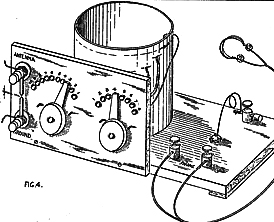
Exactly a century ago, on Sept. 29, 1915, a transcontinental radio telephone demonstration was transmitted from the U.S. naval radio station at Arlington, Va. to the naval radio station at Mare Island in San Francisco, Calif. (2500 miles), then a few hours later relayed to Honolulu, for a total of 4900 miles. The conversation took place between naval officers based at either end. The world of global communications had been transformed.
With the First World War already in progress in Europe, the success of this experiment was expected to have a revolutionary effect on communication between American naval vessels at sea and shore stations. By means of the perfected apparatus, which had been in the research stage for some time, applications could also be projected for civilian use, between officers, or even just friends, on transoceanic liners equipped with the necessary equipment.
The experiments had been carried out by the American Telephone & Telegraph Co. (AT&T) and the Western Electric Co. in cooperation with radio stations under Navy jurisdiction.
Secretary of the Navy Josephus Daniels, appointed by Pres. Woodrow Wilson, made a formal announcement of the achievement in which he expressed pride at the Navy’s cooperation with the experiment. “The use of such long distance wireless telephone communications in naval or military operations is still in an undeveloped state,” he said, “but it is expected valuable use can be made of the wonderful demonstration.”
The space through which the oral message was sent to Hawaii was greater than that between New York and anywhere in Western or Central Europe, and greater than the distance from New York to the North Pole.
James D. Ellsworth of AT&T gave this account, in part:
“That transatlantic wireless telephone communication is assured as soon as the disturbed condition in Europe will permit of tests from this country to there, is obvious when it is remembered that all scientists agree on the fact that it is much more difficult to send wireless telephone communications across land than across water. This wireless message from Washington to Hawaii had to pass over the whole of the United States…before it encountered better wireless conditions which exist when sending over large bodies of water….
“Another interesting feature of the tests was that, in a practical way, the ability to connect wireless telephone systems with wire telephone systems was shown. You have no doubt noted that Mr. Vail [president of AT&T] in his talk used a wire circuit from New York to Washington. At Washington, by the special means invented and developed by the engineers of this company, the wires are connected to our special wireless apparatus and to the navy’s mighty wireless tower, where the message went wirelessly to its destination.”
At the time, the exact apparatus used in this historic test of the wireless telephone was being kept secret owing to patent reasons.
Just think, as you Skype to your friends abroad, there are people alive today who were alive on this day 100 years ago!
Adapted from The Electrical Experimenter, November 1915.
Photo: In the 1920s, the United States government publication, “Construction and Operation of a Simple Homemade Radio Receiving Outfit,” showed how almost any person handy with simple tools could a build an effective crystal radio receiver. “NBS 120 Set” by Davidson – Scanned image from NBS Circular 120 dated 1922, cleaned it up with Photoshop. Licensed under Public Domain via Wikipedia.










